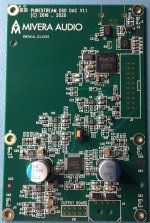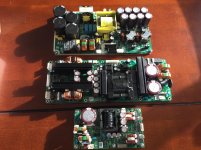Ethernet is transformer-coupled and grounds are capacitor coupled, so what is being discussed about "noise and the fiber alternative" is aesthetic criteria. Fiber is for long distance high bandwidth. Copper for anything else. Don't try to bend fiber like a copper ethernet cable can be bent (or put weight on top of it).
Concerning clocks, it has to be understood that both reconstructing a copy of source clock and using it locally, or re-sampling from source clock to local clock, require estimating source clock, which requires a PLL, which has mathematically predictable error, which can be modelled as a frequency-dependent attenuation factor multiplied by source signal skew. How much packet skew is there in a LAN dedicated to audio? Will mostly depend on packet skew of signal source.
EDIT: If you do some math, 100Mbps ethernet can theoretically send a 128byte packet every 96khz clock, and data for one clock for an audio LAN is not going to be as long as 128byte (less the network protocol overhead, even with 50% overhead, 32x 16 bit channels would be allowed, or 21x 24 bit). Going through a switch would merely delay audio by 1 96khz sample, speaker drivers (or our ears) don't have much better unit-to-unit tolerance in HF phase lag than this.
Concerning clocks, it has to be understood that both reconstructing a copy of source clock and using it locally, or re-sampling from source clock to local clock, require estimating source clock, which requires a PLL, which has mathematically predictable error, which can be modelled as a frequency-dependent attenuation factor multiplied by source signal skew. How much packet skew is there in a LAN dedicated to audio? Will mostly depend on packet skew of signal source.
EDIT: If you do some math, 100Mbps ethernet can theoretically send a 128byte packet every 96khz clock, and data for one clock for an audio LAN is not going to be as long as 128byte (less the network protocol overhead, even with 50% overhead, 32x 16 bit channels would be allowed, or 21x 24 bit). Going through a switch would merely delay audio by 1 96khz sample, speaker drivers (or our ears) don't have much better unit-to-unit tolerance in HF phase lag than this.
Last edited:
On top of this we have the fact that ethernet is full duplex, so return channel is free to establish a "back timing link" and be able to correct for average packet delay (by return_time/2), so delay from switches (or even routers) can be accurately compensated. The .25ms latency often quoted are 24 samples at 96khz, I suppose some of this latency is headroom for time offset correction and skew, rather than net delay in hardware response...
Mike,
You started the thread with announcing a Hypex plate amp not available for DIY.
Then you suggest all possible modifications for still to arrive Hypex Fusion plate amps.
You wil do this....plan to do so....telling what others do wrong....and so on...but you've got still nothing for the time being...
I have never seen this from a "manufacturer", and actually, to me at least it's becoming a bit boring.
Why not hold back a little and surprise us with something you finished??
So now it's not available for DIY anymore? They changed their minds?
Some people asked about my project and I just wanted to make it clear that it's not a system that is competition to these Hypex plates. However I've shared very little details about them other than the fiber input and clock.
Yes until these plates are in people's hands it might be a bit boring.
May you define "massive" please? In what manner/numbers?
Comparing spec sheets you wouldn't think the difference would be all that great. But sound wise night and day. All the numbers are in the spec sheets if you want numbers.
On top of this we have the fact that ethernet is full duplex, so return channel is free to establish a "back timing link" and be able to correct for average packet delay (by return_time/2), so delay from switches (or even routers) can be accurately compensated. The .25ms latency often quoted are 24 samples at 96khz, I suppose some of this latency is headroom for time offset correction and skew, rather than net delay in hardware response...
Yes that IEEE1588v2 is pretty cool. It even works with cell phones. With Ravenna and DSD 256 round trip latency from microphone/ADC/PC/DAC is only 2ms. Even with all of that bandwidth. And they can do 8 channels of DSD 256 over gigabit Ethernet to a single endpoint.
May you define "massive" please? In what manner/numbers?
At least 20 kg.
Ethernet is transformer-coupled and grounds are capacitor coupled, so what is being discussed about "noise and the fiber alternative" is aesthetic criteria. Fiber is for long distance high bandwidth. Copper for anything else. Don't try to bend fiber like a copper ethernet cable can be bent (or put weight on top of it).
The latest fiber has no problem with bending.
https://www.youtube.com/watch?v=1bHVguGn4hU
Comparing spec sheets you wouldn't think the difference would be all that great. But sound wise night and day. All the numbers are in the spec sheets if you want numbers.
I checked the spec-sheets, for sure the Linear device is better in performance at x8 the price. (As you need to parallel them)
If you can hear the difference in PSRR, then go for it. Did i understood correctly, they're used for mainly digital supply stuff on the DACs.

I checked the spec-sheets, for sure the Linear device is better in performance at x8 the price. (As you need to parallel them)
If you can hear the difference in PSRR, then go for it. Did i understood correctly, they're used for mainly digital supply stuff on the DACs.

You don't need to parallel them. But when you do the performance is better, and current output capability higher. But they do have the 3045 as well with 500mA.
On my 2 channel Purestream DAC I use 8 of them. 6 to power the AK4490 DAC chip alone, 1 for the clock, and 1 for the Xmos USB interface. Then I use the Belleson SPZ discrete regs as pre-regulators on a separate board.
Belleson Medium Current Regulators
Since the Japanese SMPS I use has a nasty ripple noise of 700uV RMS, it's important to ensure none of that gets into the DAC
Attachments
Last edited:
I checked the spec-sheets, for sure the Linear device is better in performance at x8 the price. (As you need to parallel them)
If you can hear the difference in PSRR, then go for it. Did i understood correctly, they're used for mainly digital supply stuff on the DACs.

An interesting fact that might capture your interest is the chipset used on the new Icepower 100as:

Ah, the well known IC400.......😀
What's the IC400?
Edit: Ahhh yes. But the number on the chip are the ones Doctormord is likely familiar with 🙂
Last edited:
Ah, the well known IC400.......😀
Yepp - anyone in the loop know that one...
//
Yepp - anyone in the loop know that one...
//
I guess I'm out of the loop 🙂 To my ears it's the best sounding Icepower I've heard yet. Also happens to be the cheapest.
Hypex doesn't need a chipset....... The only chip in the Ncore is a microprocessor as a failsafe and control device.
Hypex doesn't need a chipset....... The only chip in the Ncore is a microprocessor as a failsafe and control device.
Yes I know that. But still impressed with that TI chip. I did a little shootout here.
Attachments
Great article here about clocking:
IEEE 1588v2 - What Is It & Why Do We Need It?
Pay extra attention to this part:
"In the perfect world, an internal clock will take the same amount of cycles to represent a second; but the clocks that are located inside every computer, cell site or network element are not perfect. Their accuracy varies according to manufacturing standards and even silicone temperature, and as a result, they’ll simply wander over time. This wander is a change in frequency. So time synchronization does not stop at just providing a timestamp to its clients, it also implies that these clocks will be adjusted constantly, the same way a heart is synched by a pacemaker. So a time synchronization protocol must work to maintain both time and frequency over long periods."
Excellent demo of 2 clocks on different endpoints synced via IEEE1588v2, then turning off the sync to see what happens.
https://www.youtube.com/watch?v=MfTDeFrLMs0
IEEE 1588v2 - What Is It & Why Do We Need It?
Pay extra attention to this part:
"In the perfect world, an internal clock will take the same amount of cycles to represent a second; but the clocks that are located inside every computer, cell site or network element are not perfect. Their accuracy varies according to manufacturing standards and even silicone temperature, and as a result, they’ll simply wander over time. This wander is a change in frequency. So time synchronization does not stop at just providing a timestamp to its clients, it also implies that these clocks will be adjusted constantly, the same way a heart is synched by a pacemaker. So a time synchronization protocol must work to maintain both time and frequency over long periods."
Excellent demo of 2 clocks on different endpoints synced via IEEE1588v2, then turning off the sync to see what happens.
https://www.youtube.com/watch?v=MfTDeFrLMs0
Last edited:
Yes I know that. But still impressed with that TI chip. I did a little shootout here.
I would love details..... particularly as to how they sound vs the nc500
I would love details..... particularly as to how they sound vs the nc500
Well it only took me 10 seconds to decide I didn't like the 700asc. And it didn't get any better after I listened more. For me it's a subwoofer amp. But when I listened to the 100as, I was very shocked. I was actually hearing music coming from my speakers. I knew something was very different about this amp than all other Icepower's I heard. So that's when I decided to pull off the heatsink and see what the secret weapon was. It's definitely the 2nd best class D I've heard next to Ncore. And it's very close. But I haven't been able to get better sound out of any class d amp than I've gotten out of the NC-500's. But at much higher expense. My last NC-500 build is the best amp I've ever heard. My class A aficionado client who bought it also agrees. He went from a DHT tube preamp with class A amp to passive Autoformer preamp, and NC-500's and for him it's an endgame. He doesn't miss the old rig at all.
Last edited:
- Home
- Amplifiers
- Class D
- The New Hypex Fusion Plate amps

